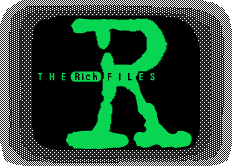
Description
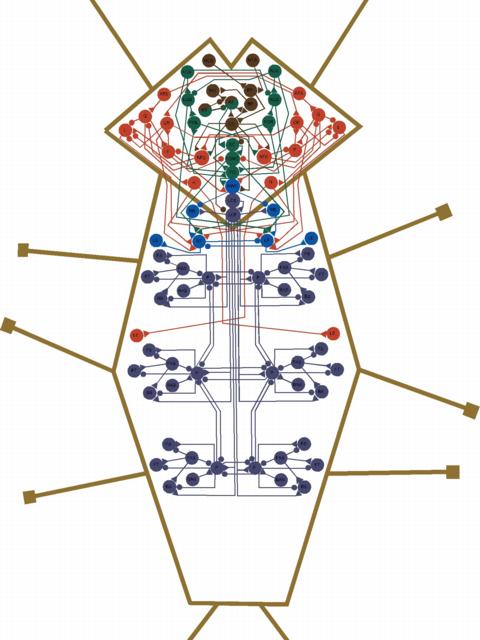
Click for a full resolution image of the Periplaneta Computatrix Neural diagram.
Periplaneta Computatrix was created by Randall D Beer about two decades ago as a computer simulation. It is a 78 neuron 156 connection neural network inspired by the cockroach Periplaneta Americana. I'll post more info later, including the original article where I read about it. Recently, I've found a high resolution scan of the original network. I'm want to build the body section (the lower image of the two above images). The head section is much more complex and will be a "second" priority. I do see some similarities to early BEAM robotics concepts hidden in this neural network.
My top goal is learning more about the symbology of this diagram. There appears to be several different types of symbols used. I will be filling in information below, as I receive it. I still have uncertainties as to how to interpret some of them. The following lists trimmed or highlighted images of segments from the diagram to point out a particular feature. If you have suggestions regarding how to interpret these symbols properly, please contact me at richfiles@comcast.net. I would greatly appreciate solving the complexities of this design, as it has fascinated me since my teen years.
UPDATE: I've received some new information, rather quickly...
Intelligence as Adaptive Behavior By Randall D Beer (At Amazon)
First, I discovered this fine book that has all the answers.
I’ll update this page with some clarifications and new details, once I’ve gone through it.

EXCITATORY connections are identified by the triangle symbol.
INHIBITORY connections are identified by the circle symbol.
LINES with no symbol are identified as outputs from a node.

I would assume that this is a SENSOR node. Since I've confirmed that the simple line is an output, I would presume the the sensory input is the only means of activation. This is presumed because there are no input lines.

I think this is a MOTOR node. The Excitatory or Inhibitory input symbols (Triangle or Circle, respectively) without the simple line as an output suggests this node has input(s), but no outputs. With no output, I'm assuming this is a motor control node. I imagine it's possible for a node to also have outputs, but I'm unsure if this is the case or not in this design.
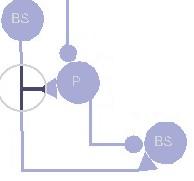
A split in a single line output to 2 or more excitatory or inhibitory inputs is possible. Neurons typically will have multiple weighted inputs, and fire a single output that can lead to one or many other neurons.
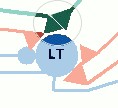
This is something that I'm not certain how to make out. It relates to the next symbol. It appears that one of the inputs is stacked on top of another input of the same type. I'm not exactly certain how this structure functions. I don't know if this is an easy way to wrap more standard inputs around the circumference of a limited diameter node symbol, or if it is a genuine, unique structure. I believe I've seen something like this before, but I can't recall where.
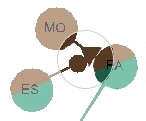
This is something that I'm not certain how to make out. It relates to the previous symbol. It appears that one of the presumed inputs is stacked on top of another input of the opposing type. I'm not exactly certain how this structure functions. I don't know if this is an easy way to wrap more standard inputs around the circumference of a limited diameter symbol, or if it is a genuine, unique structure.
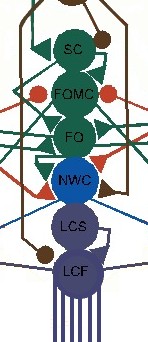
This thing has me wondering as well. Are these separate, but extraordinarily closely spaced nodes, or is there a unique connection between these "touching" nodes. Note the second bottom node appears to only have an output. This suggests it is either a sensor in the middle of the stack, or it is a normal hidden node and that there is a connection of some sort within the nodes of the stack. I could also imagine this as a sort of "pacemaker" node, that simply produces a steady stream of pulses.
Finally, there is color coding and some abbreviations on some nodes and lines. Again, I need more information on this, as I STILL have yet to find the original article. I'm thinking it was a Discover Magazine, or a Scientific American. If anyone has papers, magazine articles, or web references that describe details, I'd greatly appreciate it. If I can find any documents related to this design, they might reveal some of these unknown details, or the overall structure or functionality of this system. Again, please email me at richfiles@comcast.net if you have any information, or even theories.
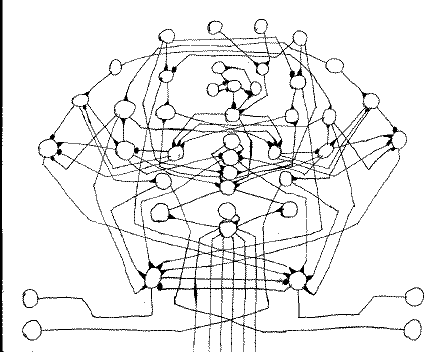
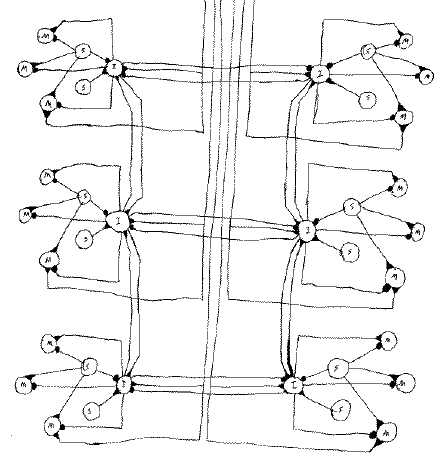
The Richfiles is copyright © 1996-2016. All Rights Reserved.